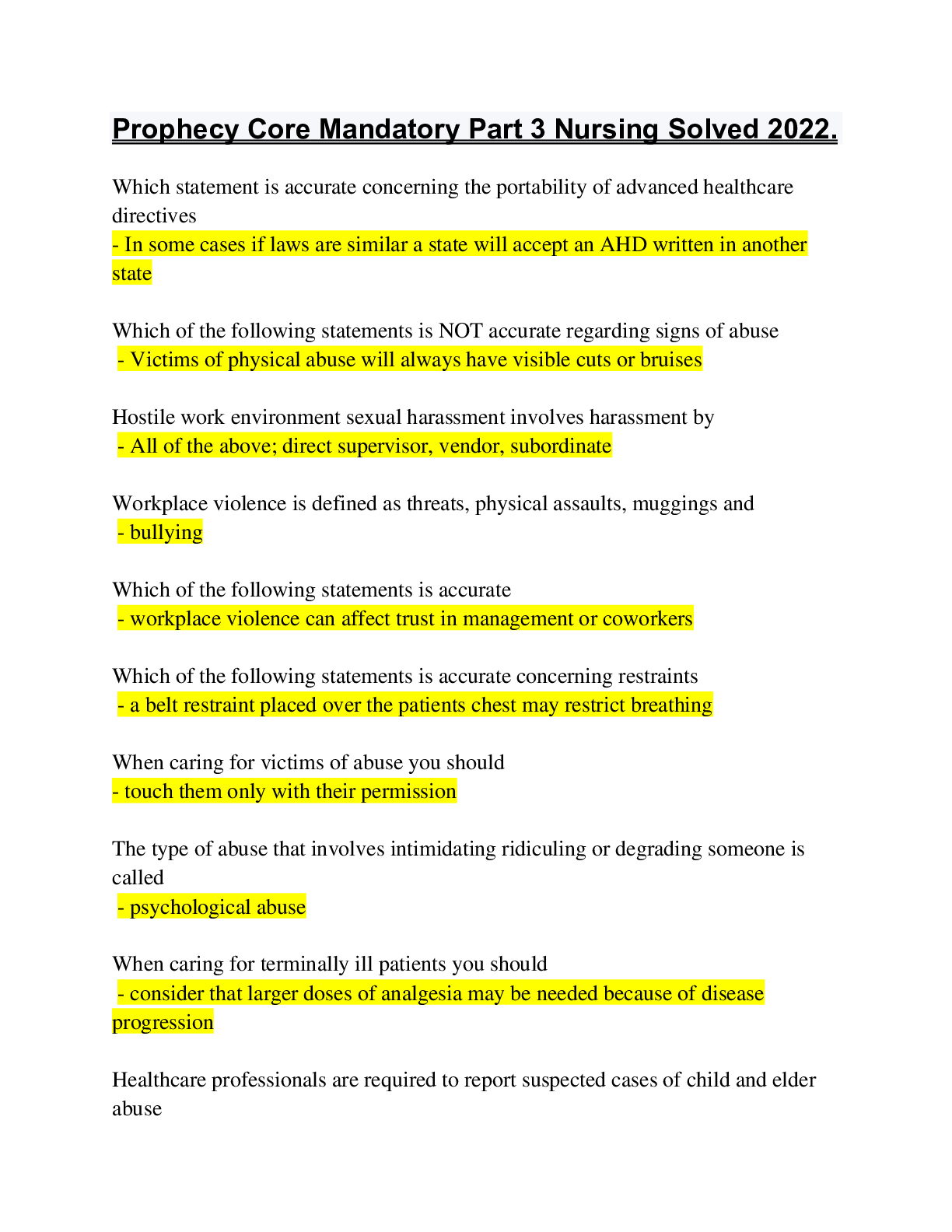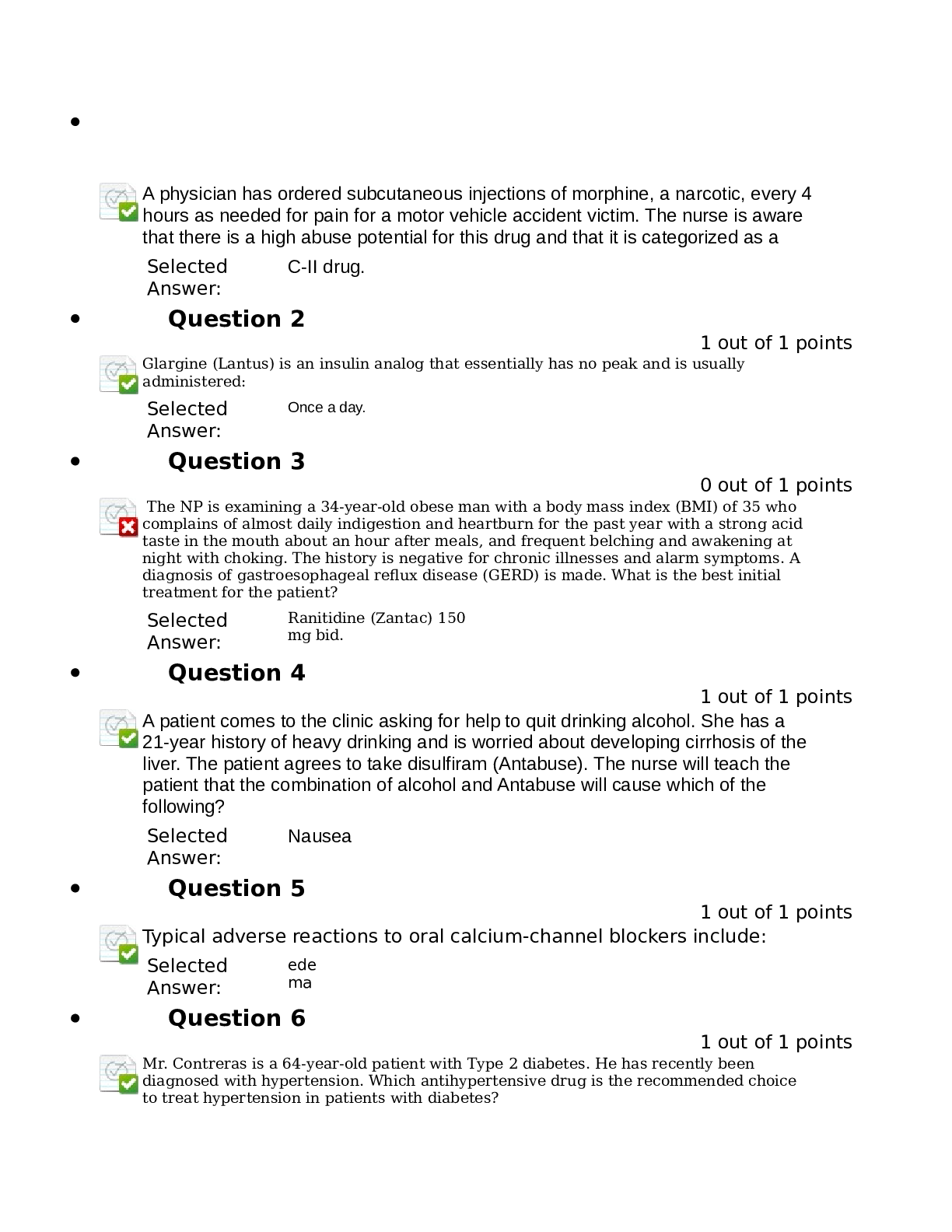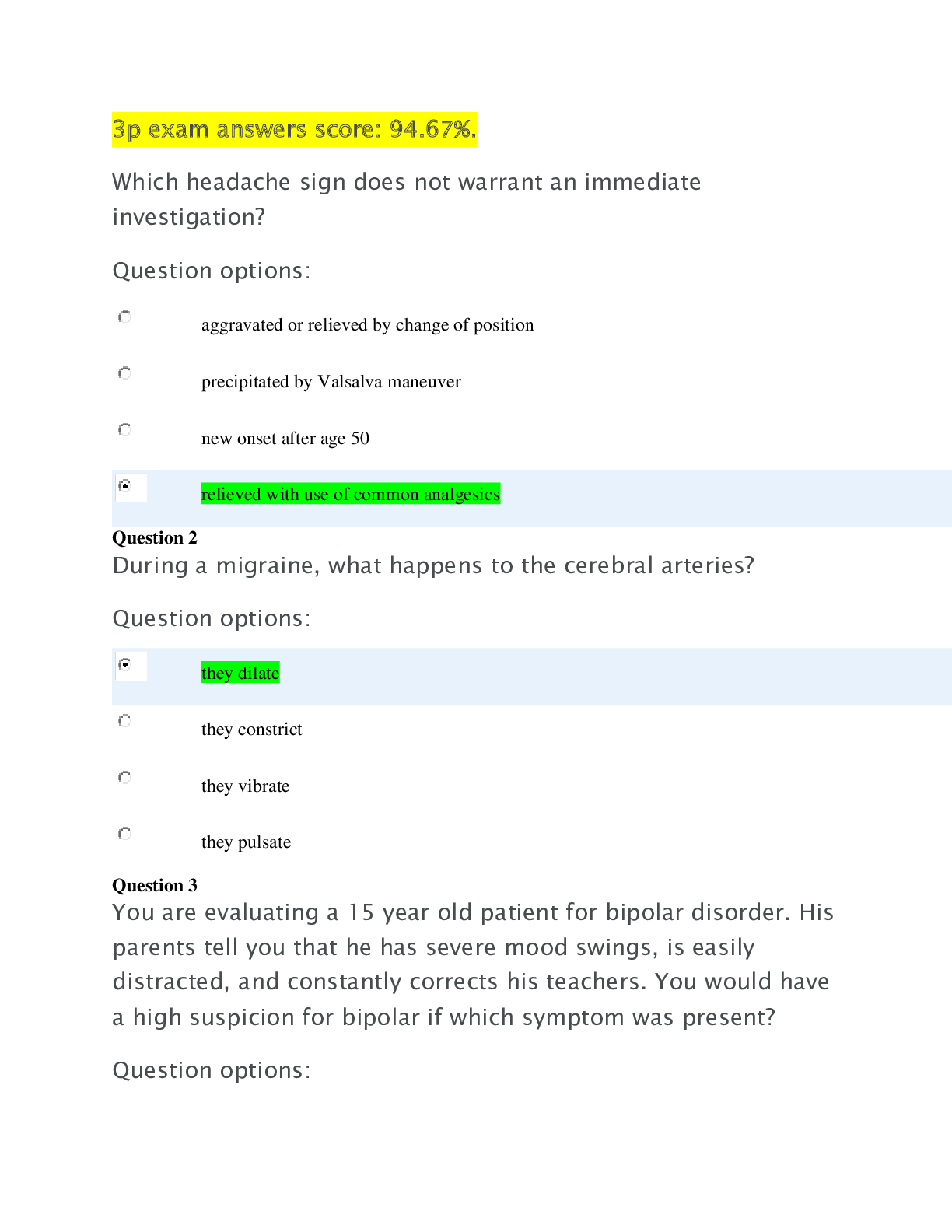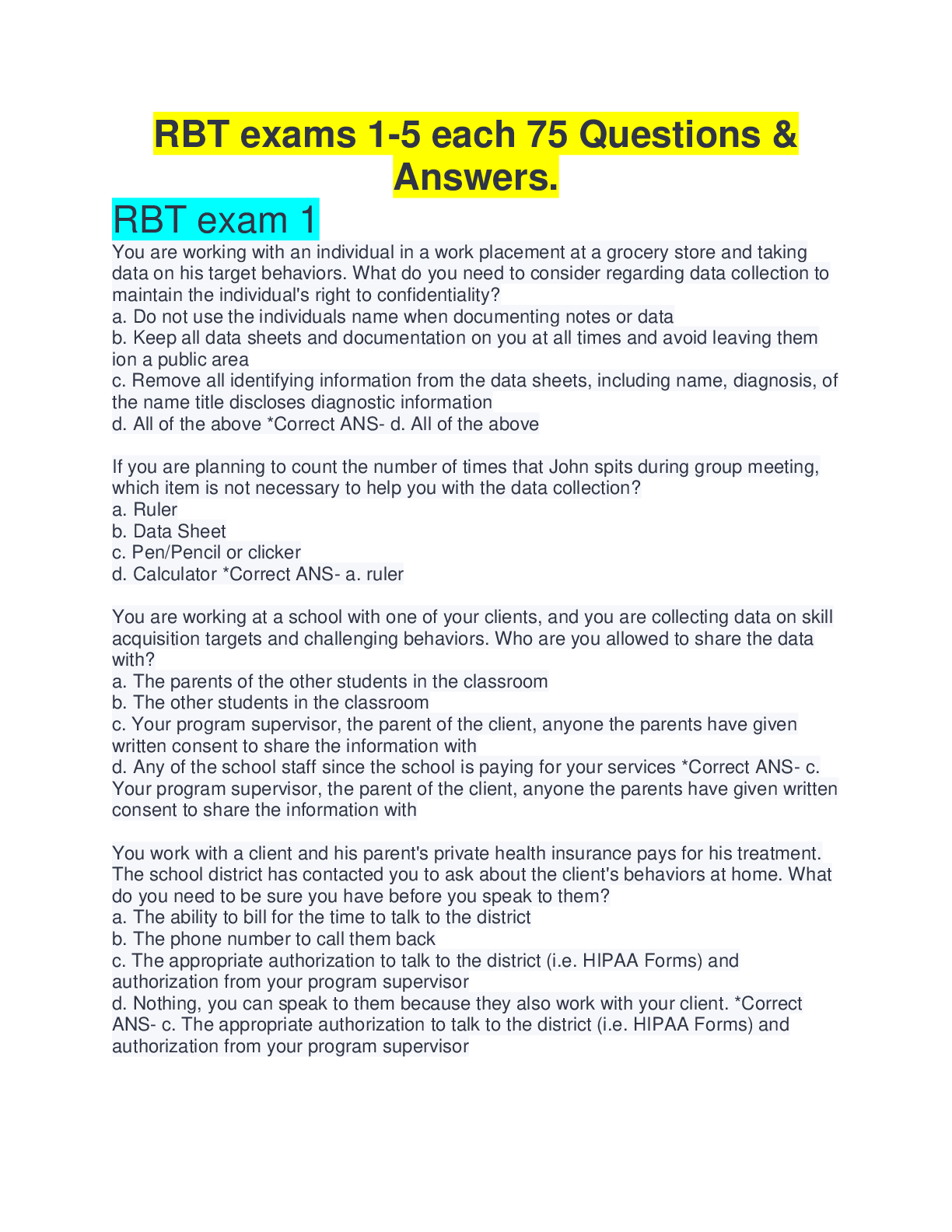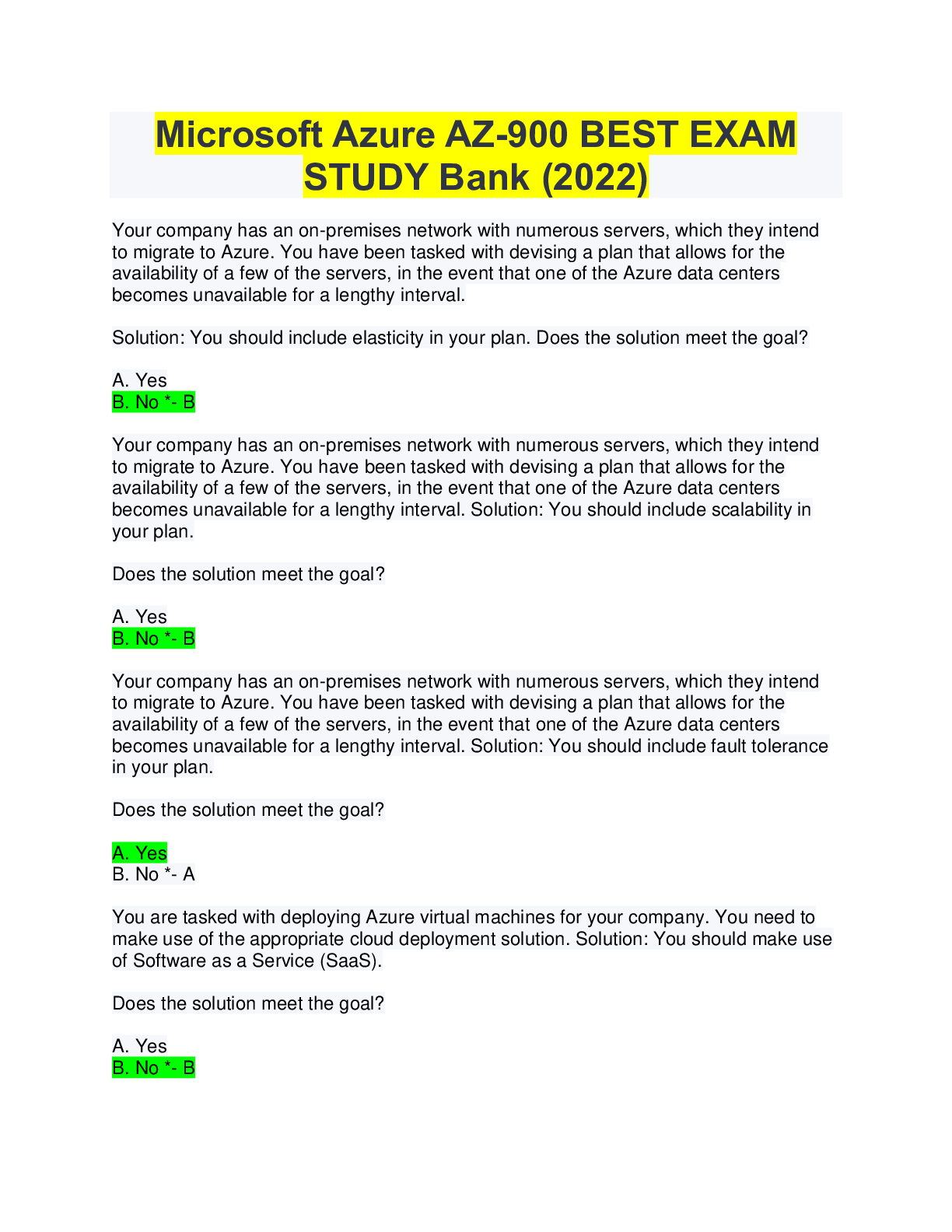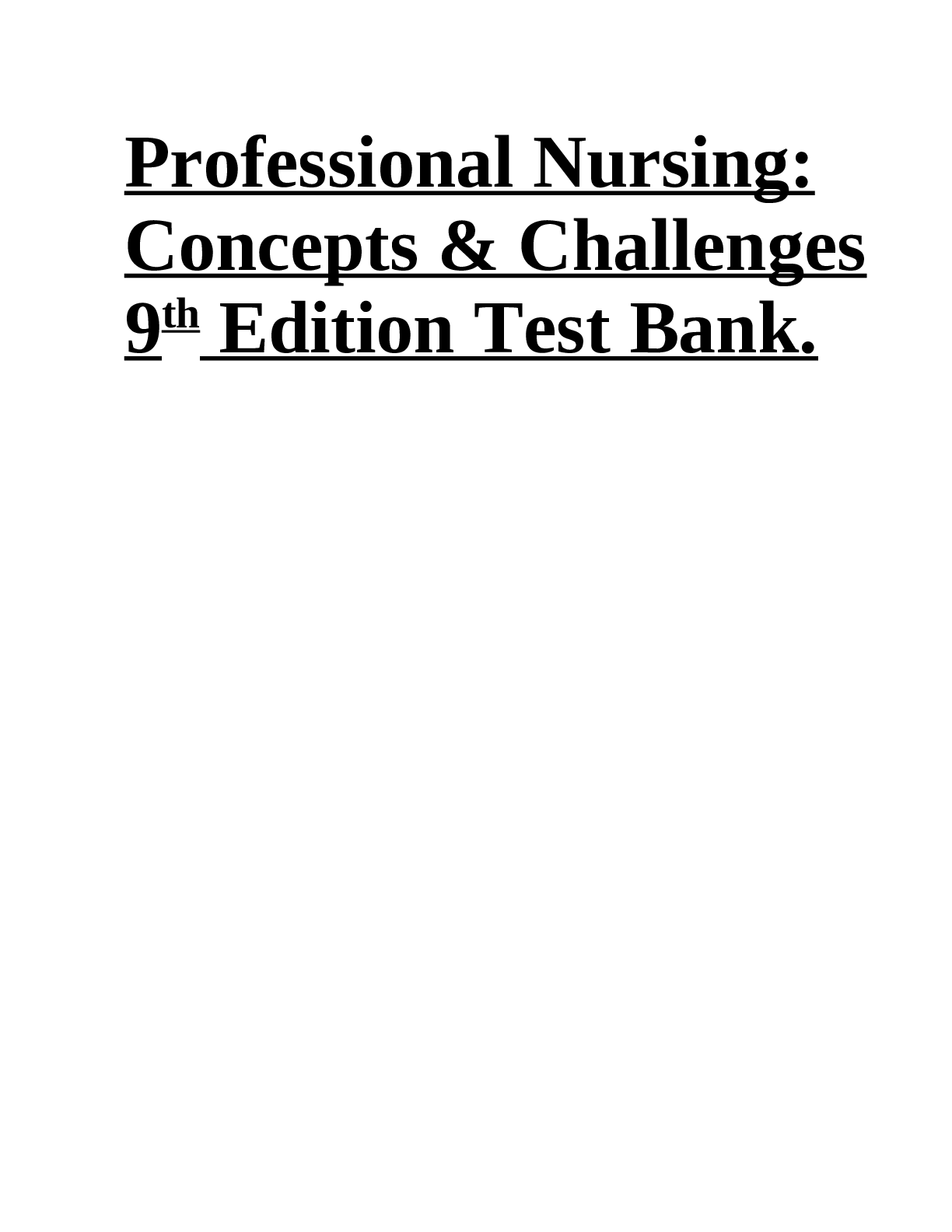*NURSING > EXAM > Chapter 03: Fluid, Electrolytes, Acid-Base Balance, and Intravenous Therapy deWit: Medical-Surgical (All)
Chapter 03: Fluid, Electrolytes, Acid-Base Balance, and Intravenous Therapy deWit: Medical-Surgical Nursing: Concepts & Practice, 3rd Edition
Document Content and Description Below
Chapter 03: Fluid, Electrolytes, Acid-Base Balance, and Intravenous Therapy deWit: Medical-Surgical Nursing: Concepts & Practice, 3rd Edition MULTIPLE CHOICE 1. The nurse uses a diagram to de... monstrate how in dehydration the water is drawn into the plasma from the cells by which process? 2. The nurse assessing a patient with vomiting and diarrhea observes that the urine is scant and concentrated. Which controlling factor is responsible for compensatory reabsorption of water? 3. The nurse uses a picture to show how ions equalize their concentration by which passive transport process? 4. Which term describes the active transport process that moves sodium and potassium into or out of cells? 5. The patient taking furosemide (Lasix) to correct excess edema shows a weight loss of 5.5 pounds in 24 hours. The nurse calculates that this weight loss is equivalent to how many liters (L) of fluid? 6. The nurse is caring for a patient with a potassium level of 2.9 mEq/L. The nurse should carefully monitor the patient for which potential problem? 7. While the nurse is washing the face of a patient in renal failure, the patient demonstrates a spasm of the lips and face. Which laboratory value corresponds with the nurse’s assessment findings? 8. Which finding is most important for the nurse to confirm prior to hanging an intravenous (IV) bag containing potassium? 9. Which statement demonstrates that the patient accurately understands the nurse’s teaching related to a low-sodium diet? 10. The nurse is caring for an 80-year-old patient. Which finding is the best early indicator of dehydration in this patient? a. Constipation b. Increased temperature c. Thirst ANS: B The nurse understands that this patient’s age places him at greater risk for dehydration. Constipation is the best early indicator of dehydration in the older adult. Older adults have age-related poor skin turgor. Increased temperature and thirst are later signs of dehydration. PTS: 1 DIF: Cognitive Level: Analysis REF: 33-34 OBJ: 5 (theory) TOP: Dehydration in the Older Adult KEY: Nursing Process Step: Assessment MSC: NCLEX: Health Promotion and Maintenance: Prevention and Early Detection of Disease 11. The patient with long-term obstructive pulmonary disease has a pH of 7, HCO3– of 18 mEq/L, and a PaCO2 of 40 mm Hg. These laboratory values are consistent with which acid-base imbalance? a. Respiratory alkalosis b. Metabolic alkalosis c. Respiratory acidosis d. Metabolic acidosis ANS: D These results are indicative of metabolic acidosis. PTS: 1 DIF: Cognitive Level: Application REF: 46 OBJ: 15 (clinical) TOP: Respiratory Acidosis KEY: Nursing Process Step: AssessNmUenRtSINMGSTCB.:CNOMCLEX: Health Promotion and Maintenance 12. The nurse is caring for a young patient with asthma. Which activity should the nurse encourage in order to help prevent respiratory acidosis? a. Engage in deep-breathing exercises every 2 hours. b. Drink 8 ounces of fluid every 4 hours. c. Ambulate for 15 minutes twice a day. d. Sleep with the head of the bed elevated 45 degrees. ANS: A Deep breathing blows off CO2, which reduces the acid ions, thus preventing respiratory acidosis. Drinking fluids prevents dehydration and keeps secretions moist and thin, and sleeping with the head of the bed elevated will ease breathing and improve gas exchange. Ambulating 15 minutes twice a day does not have an impact on respiratory acidosis. PTS: 1 DIF: Cognitive Level: Analysis REF: 46 OBJ: 8 (theory) TOP: Respiratory Acidosis KEY: Nursing Process Step: Implementation MSC: NCLEX: Health Promotion and Maintenance: Prevention and Early Detection of Disease 13. The patient who has had diarrhea for the last 3 days has blood gases of pH of 7.1, HCO3- of 20 mEq/L, and PCO2 of 36 mm Hg. These laboratory values are consistent with which acid-base imbalance? a. Respiratory alkalosis b. Metabolic alkalosis c. Respiratory acidosis d. Metabolic acidosis ANS: D Metabolic acidosis shows a low pH, low HCO3-, and normal CO2. PTS: 1 DIF: Cognitive Level: Application REF: 46 OBJ: 8 (theory) TOP: Metabolic Acidosis KEY: Nursing Process Step: Assessment MSC: NCLEX: Health Promotion and Maintenance 14. The nurse is caring for a patient with metabolic acidosis. Which assessment finding reveals that the compensatory mechanism to correct this imbalance is in effect? a. Increased urinary output b. Reduced abdominal distention c. Kussmaul respirations d. Decreased blood pressure ANS: C Kussmaul respirations, or deep and rapid respirations, are blowing off carbon dioxide to reduce an acidotic state. PTS: 1 DIF: Cognitive Level: Application REF: 47 OBJ: 7 (theory) TOP: Metabolic Acidosis KEY: Nursing Process Step: Assessment MSC: NCLEX: Physiological Integrity: Physiological Adaptation 15. The nurse assesses the patient’s IV insertion site and observes that the vein is hard, the skin is red and tender, and a blood returnNinURthSeINIGVTlBin.CeO. AMfter removing the IV catheter, which action should the nurse take next? a. Obtain an arm board to properly secure the IV. b. Elevate the arm above the level of the heart. c. Clean the site with alcohol and apply cool compresses. d. Apply a warm moist pack. ANS: D These are signs and symptoms of phlebitis and should be treated with a warm moist pack to increase blood flow to the area. The IV has been discontinued, so an arm board for stabilization is unnecessary. Elevation of the arm would be helpful to reduce swelling. A cool compress would be indicated for other issues related to IV infusion problems, such as extravasation. PTS: 1 DIF: Cognitive Level: Application REF: 51 OBJ: 18 (clinical) TOP: Phlebitis KEY: Nursing Process Step: Implementation MSC: NCLEX: Physiological Integrity: Basic Care and Comfort 16. Because there are no IV pumps available for the immediate infusion of an IV medication, the nurse must calculate the flow rate for 500 mL to run for 4 hours, using a set that delivers 15 gtt/mL. Which flow rate is correct? a. 30 gtt/min b. 35 gtt/min c. 40 gtt/min d. 45 gtt/min [Show More]
Last updated: 1 year ago
Preview 1 out of 10 pages
Instant download

Buy this document to get the full access instantly
Instant Download Access after purchase
Add to cartInstant download
Reviews( 0 )
Document information
Connected school, study & course
About the document
Uploaded On
Jul 11, 2021
Number of pages
10
Written in
Additional information
This document has been written for:
Uploaded
Jul 11, 2021
Downloads
0
Views
57


